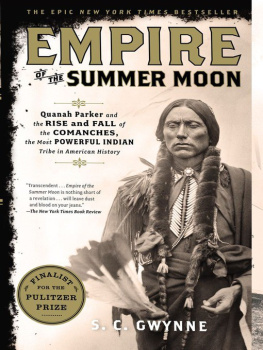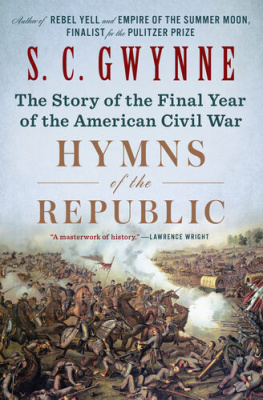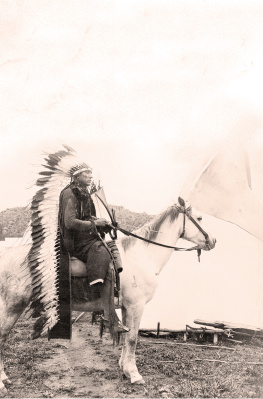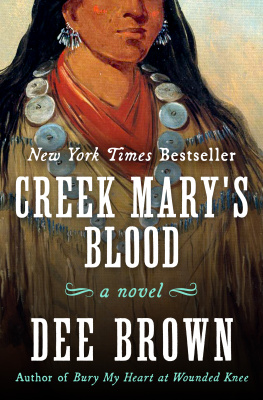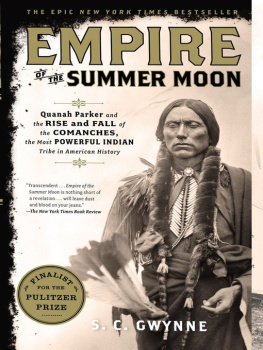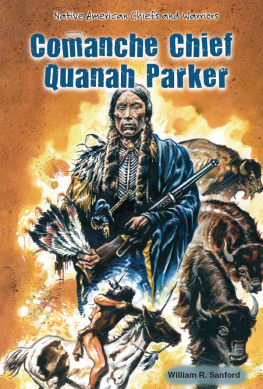
Also by the Author
Selling Money
The Outlaw Bank
EMPIRE

SUMMER MOON

Quanah Parker and the Rise and Fall of the
Comanches, the Most Powerful Indian
Tribe in American History

S. C. Gwynne
Scribner
New York London Toronto Sydney

SCRIBNER
A Division of Simon & Schuster, Inc.
1230 Avenue of the Americas
New York, NY 10020
www.SimonandSchuster.com
Copyright 2010 by S. C. Gwynne
All rights reserved, including the right to reproduce this book or portions thereof in any form whatsoever. For information, address Scribner Subsidiary Rights Department, 1230 Avenue of the Americas, New York, NY 10020.
First Scribner hardcover edition May 2010
SCRIBNER and design are registered trademarks of The Gale Group, Inc.,
used under license by Simon & Schuster, Inc., the publisher of this work.
For information about special discounts for bulk purchases, please contact
Simon & Schuster Special Sales at 1-866-506-1949 or
business@simonandschuster.com.
The Simon & Schuster Speakers Bureau can bring authors to your live event.
For more information or to book an event, contact the Simon & Schuster Speakers Bureau at 1-866-248-3049 or visit our website at www.simonspeakers.com.
Book design by Kelvin P. Oden/Oh Snap! Design
Manufactured in the United States of America
1 3 5 7 9 10 8 6 4 2
Library of Congress Control Number: 2009049747
ISBN 978-1-4165-9105-4
ISBN 978-1-4165-9715-5 (ebook)
Insert photograph credits: 1, 4, 12 courtesy of the Dolph Briscoe Center for American History, University of Texas, Joseph E. Taulman Collection; 3, 68, 10 courtesy of the Panhandle Plains Historical Museum; 9, 13, 15, 17 courtesy of the Fort Sill Museum; 14, 16, 18 courtesy of the Oklahoma Historical Society; 2 courtesy of the Library of Congress; 5 courtesy of the Baylor University Library, Waco Texas
To Katie and Maisie

The desert wind would salt their ruins and there would be nothing, no ghost or scribe, to tell any pilgrim in his passing how it was that people had lived in this place and in this place had died.
Cormac McCarthy
CONTENTS
EMPIRE OF THE SUMMER MOON


One

A NEW KIND OF WAR

CAVALRYMEN REMEMBER SUCH moments: dust swirling behind the pack mules, regimental bugles shattering the air, horses snorting and riders tack creaking through the ranks, their old company song rising on the wind: Come home, John! Dont stay long. Come home soon to your own chick-a-biddy!1868 were examples. But in those days there was no real attempt to destroy the tribes on a larger scale, no stomach for it. That had changed, and on October 3, the change assumed the form of an order, barked out through the lines of command to the men of the Fourth Cavalry and Eleventh Infantry, to go forth and kill Comanches. It was the end of anything like tolerance, the beginning of the final solution.
The white men were grunts, bluecoats, cavalry, and dragoons; mostly veterans of the War Between the States who now found themselves at the edge of the known universe, ascending to the turreted rock towers that gated the fabled Llano EstacadoCoronados term for it, meaning palisaded plains of West Texas, a country populated exclusively by the most hostile Indians on the continent, where few U.S. soldiers had ever gone before. The llano was a place of extreme desolation, a vast, trackless, and featureless ocean of grass where white men became lost and disoriented and died of thirst; a place where the imperial Spanish had once marched confidently forth to hunt Comanches, only to find that they themselves were the hunted, the ones to be slaughtered. In 1864, Kit Carson had led a large force of federal troops from Santa Fe and attacked a Comanche band at a trading post called Adobe Walls, north of modern-day Amarillo. He had survived it, but had come within a whisker of watching his three companies of cavalry and infantry destroyed.
The troops were now going back, because enough was enough, because President Grants vaunted Peace Policy toward the remaining Indians, run by his gentle Quaker appointees, had failed utterly to bring peace, and finally because the exasperated general in chief of the army, William Tecumseh Sherman, had ordered it so. Shermans chosen agent of destruction was a civil war hero named Ranald Slidell Mackenzie, a difficult, moody, and implacable young man who had graduated first in his class from West Point in 1862 and had finished the Civil War, remarkably, as a brevet brigadier general. Because his hand was gruesomely disfigured from war wounds, the Indians called him No-Finger Chief, or Bad Hand. A complex destiny awaited him. Within four years he would prove himself the most brutally effective Indian fighter in American history. In roughly that same time period, while General George Armstrong Custer achieved world fame in failure and catastrophe, Mackenzie would become obscure in victory. But it was Mackenzie, not Custer, who would teach the rest of the army how to fight Indians. As he moved his men across the broken, stream-crossed country, past immense herds of buffalo and prairie-dog towns that stretched to the horizon, Colonel Mackenzie did not have a clear idea of what he was doing, where precisely he was going, or how to fight Plains Indians in their homelands. Neither did he have the faintest idea that he would be the one largely responsible for defeating the last of the hostile Indians. He was new to this sort of Indian fighting, and would make many mistakes in the coming weeks. He would learn from them.
For now, Mackenzie was the instrument of retribution. He had been dispatched to kill Comanches in their Great Plains fastness because, six years after the end of the Civil War, the western frontier was an open and bleeding wound, a smoking ruin littered with corpses and charred chimneys, a place where anarchy and torture killings had replaced the rule of law, where Indians and especially Comanches raided at will. Victorious in war, unchallenged by foreign foes in North America for the first time in its history, the Union now found itself unable to deal with the handful of remaining Indian tribes that had not been destroyed, assimilated, or forced to retreat meekly onto reservations where they quickly learned the meaning of abject subjugation and starvation. The hostiles were all residents of the Great Plains; all were mounted, well armed, and driven now by a mixture of vengeance and political desperation. They were Comanches, Kiowas, Arapahoes, Cheyennes, and Western Sioux. For Mackenzie on the southern plains, Comanches were the obvious target: No tribe in the history of the Spanish, French, Mexican, Texan, and American occupations of this land had ever caused so much havoc and death. None was even a close second.
Next page
